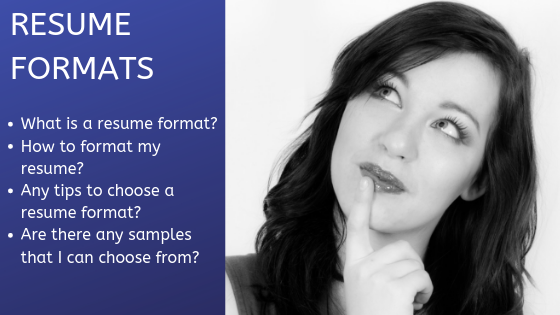In order to achieve a well-written resume, you need to have a resume format in place. And that could just be the difference that leads to a response. In this article, we cover all areas relating to resume formats, including:
- What is a resume format?
- Types of resume format
- How to format your resume
- Any tips to choose a resume format?
- Resume format examples: Are there any samples that I can choose from?
You may also want to take a look at cover letter formats here: Cover Letter Format: The What, Why and How of Writing One that Gets You the Interview
What is a resume format?
Put briefly, a resume format is what lets you showcase who you are, what your capabilities are and what you have done.
Types of resume format
While there are different types of resume format, the one that suits you best depends on your industry and professional background. Here are the three main types of resume format:
Chronological resume format
Ideal for: Experienced professional continuing in the same industry
The chronological resume format is the most commonly used one. It lists down your professional journey in chronological order, mostly in reverse, with all the companies you have worked for along with the duration of your employment under each. The chronology is based on your professional summary, your work history along with any rewards and recognition, your technical and soft skills, and educational qualifications.
Benefits of chronological resume format
- Summarises your work history perfectly
- Easily showcases your career path
- Preferred by most recruiters
- Ideal resume format for for 3-5 years’ experience
Some ideas to make your resume interesting: Top Resume Writing Tips for Employees over 40
Functional resume format
Ideal for: Those who keep changing careers frequently or employment gaps
The functional resume format is used for when you want to highlight the skills and educational qualifications of your career history. This type of resume format is useful in removing focus from your professional history in case you are fresher, someone looking to switch to another industry or someone who has had gaps in their employment. So, if you are on any of these paths, choose the functional resume format.
Benefits of functional resume format
- Focuses on important achievements
- Highlights your skills
- Removes focus away from an irregular work history
- Ideal resume format for freshers or 1-3 years’ experience
Restarting your career? Read this: How to Approach Job Search After a Long-term Employment?
Hybrid resume format
Ideal for: Recent graduates, industry professionals, and career-switchers
As the name suggests, the hybrid resume format is a combination of the chronological and functional resume formats. It focuses on your skills section along with highlighting your work history. This makes the hybrid resume format a great choice for graduates, those with a varied employment history and those who are looking to switch industries.
Benefits of hybrid resume format
- Highlights both skills and work experience
- Less emphasis on work history
- Offers chronology in information
- Ideal resume format for freshers
How to format your resume
Name and contact details
Start with your full name and contact details at the top of your resume. Choose a neat layout to present all of your contact information with minimal clutter. This information should include your mobile number and a professional email ID.
Professional summary
Begin your resume with a brief recap of your professional journey. Keep it short but reflective of your professional adeptness and relevant qualities. Your professional summary should be engaging enough to lead the recruiter towards the rest of your resume.
Skills
Highlight your most relevant skills as per the job profile. Along with that, make sure you incorporate as many keywords from the job description of the profile as you can. This helps your chances of getting recognised by the applicant tracking system.
Work experience
This is where you list out your employers and titles held. Begin with your job title, followed by the name and location of the organisation along with the time period of your employment with them. Under each organisation, list out your most important responsibilities as well as important achievements.
Education
In this section, list out your educational qualifications in a reverse chronological order – from latest to earliest. If you have had any special training or certifications relevant to the profile, mention them here.
Any tips to choose a resume format?
- No matter which resume format you go with, make sure the layout is such that it is easily understood by your recruiter. This also includes your font selection and size. Use clear fonts such as Arial, Verdana, Calibri, etcetera, and keep the size between 10 and 12 to ensure maximum readability.
- Except for your top header (displaying your name and contact information), avoid too many decorative elements, to keep your resume applicant tracking system-friendly.
- Be consistent in how you format your resume. This means, whatever styling you choose for one section must be followed for all sections. For example, if you make one section name bold or italicise it or underline it or capitalise it, do the same for all. But do not overuse any style.
- In case you are applying for a creative position, such as in designing, your resume formatting guidelines will differ greatly. Everything from your font style, to your layout would be a way of displaying your designing skills.
Resume format examples: Are there any samples that I can choose from?
Chronological resume format sample

Functional resume format sample

Hybrid resume format sample

Similar reads for you:
More Resource : Job vacancies in kochi | Job vacancies in navi mumbai | Java interview questions | Engineering interview question & answers




